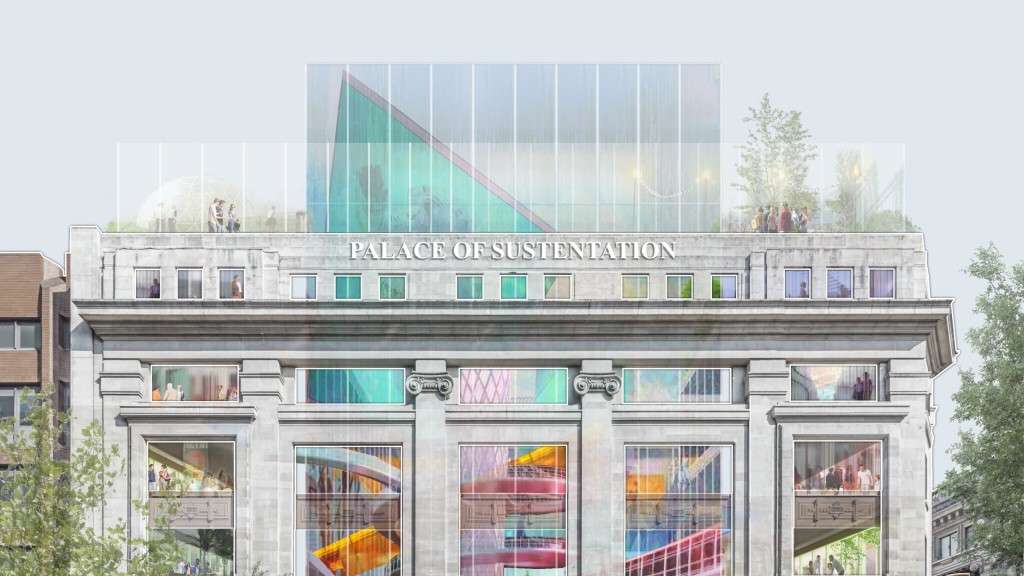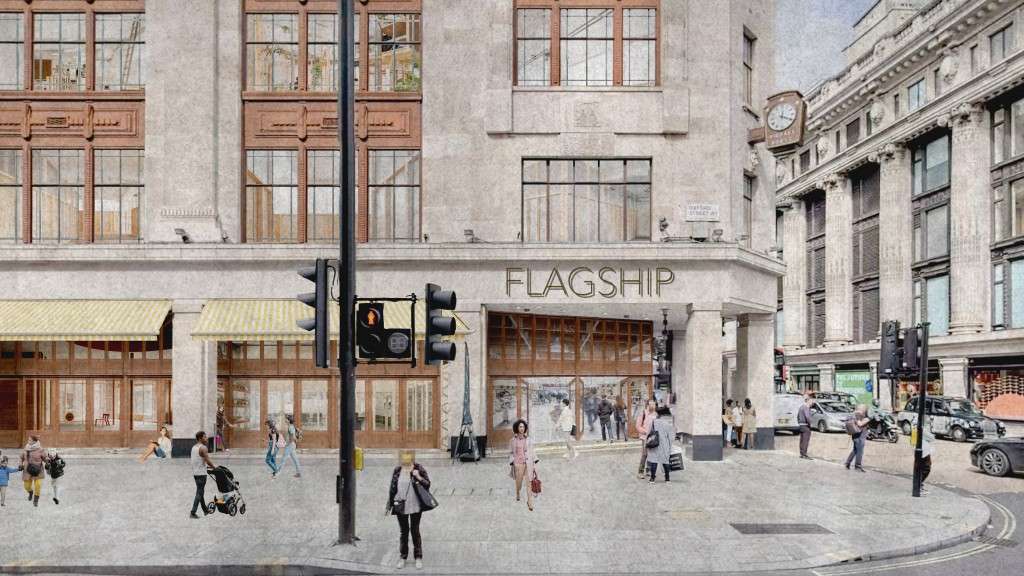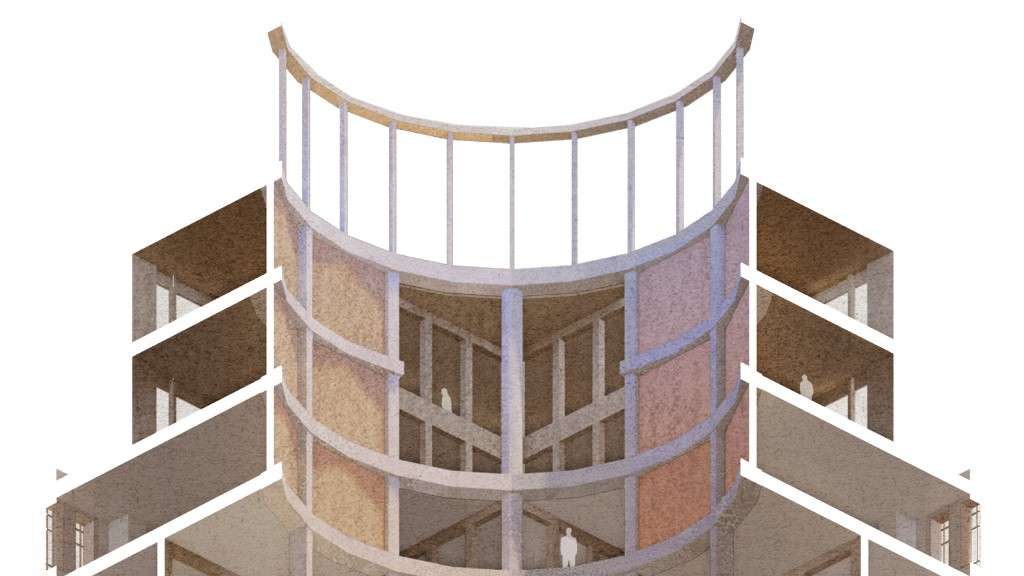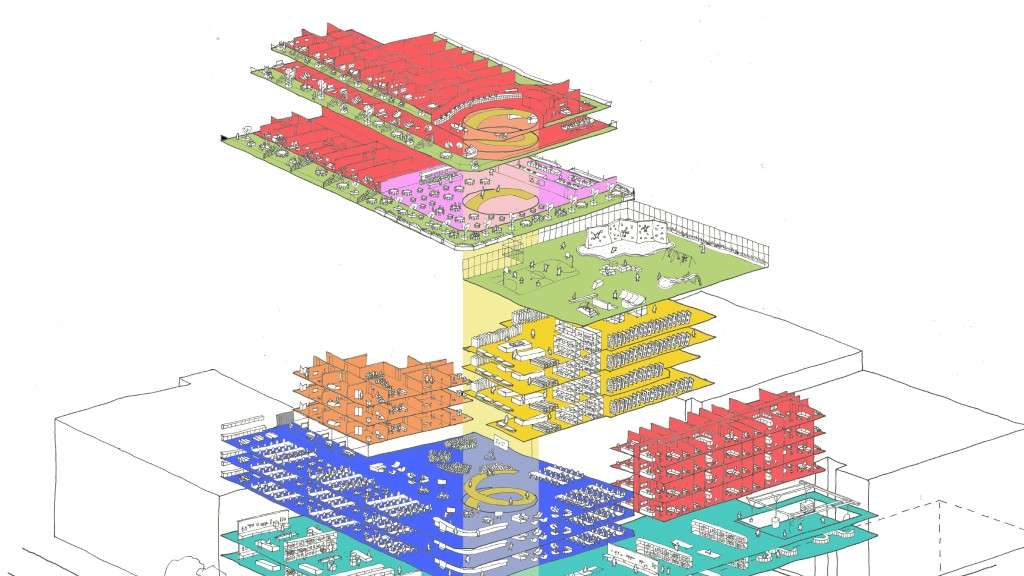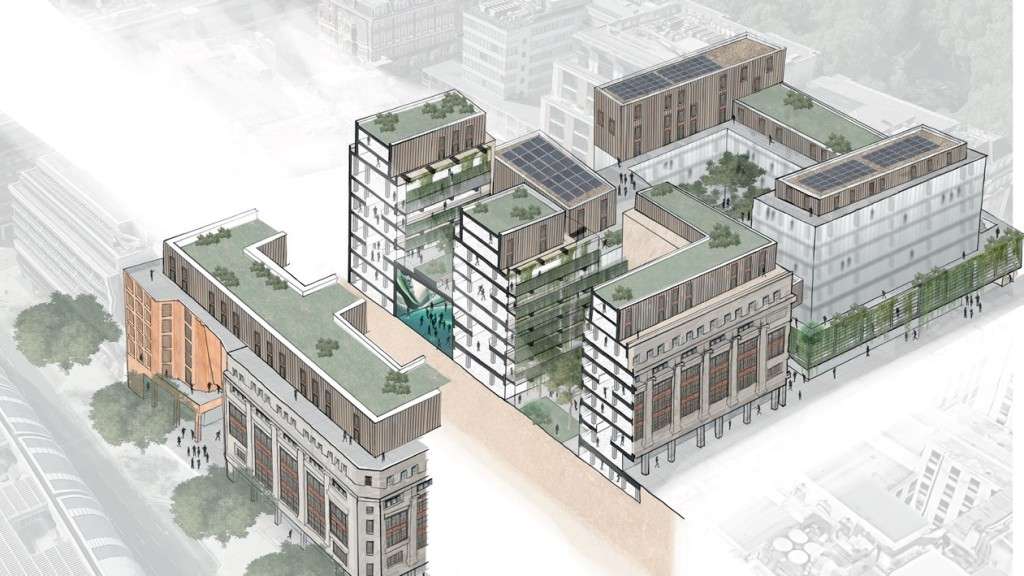Press release: Finalists announced in Re:store ideas competition for M&S Oxford Street site
Judges pick six teams to take part in live charrette
16th May 2024
Judges for Re:store, the Architects’ Journal and SAVE Britain’s Heritage architecture competition, have selected six teams to work up their ideas for the M&S Oxford Street building.
The six teams are: Connolly Wellingham, Saqqra, Jestico + Whiles, Marks Barfield, Avanti Architects and Add Apt.
Each will receive a £5,000 honorarium and participate in a day-long charrette to develop their concepts further through sketching, model-making, and discussion, to be held next Thursday (23rd May) at Ravensbourne University in North Greenwich.
The teams were selected from a longlist of 13 by a judging panel comprising architects Simon Henley and Sanaa Shaikh, London School of Architecture chief executive Neal Shasore and the AJ’s sustainability editor Hattie Hartman.
The free-to enter Re:store competition, which was open to UK-based architects, architectural assistants and architecture students, seeks to explore whether a new lease of life can be found for Marks & Spencer’s flagship store on Oxford Street. The building dates back to 1929 but is under threat from a highly controversial demolition and rebuild plan drawn up for M&S by architect Pilbrow + Partners.
The retrofit-first focused contest, which is independent of M&S, aims to tap into the creativity and imagination of architects and others in the built environment and retain the fabric of the existing building as much as possible.
It asks entrants to meet five key objectives including prioritising whole-life carbon design principles, preserving heritage and recognising the challenges facing the world-famous Oxford Street, and potentially other high streets elsewhere in the country.
Oxford Street was back in the news this week after London paper the Evening Standard revealed hopes that a £1bn investment boom will transform its fortunes and restore its place as Europe’s premier shopping destination after “the years of candy store blight”. In a four-page report, the Standard said: “Global brands are now scrambling to secure space along the West End’s 1.2-mile canyon of consumerism after a remarkable turnaround since the end of the pandemic.”
Many buildings are undergoing comprehensive retrofits, such as Studio PDP’s transformation of the 1930s House of Fraser building, AHMM’s reworking of the former Debenhams, and BDP’s design for a new Ikea, housed in a grade II-listed building at Oxford Circus, formerly home to Topshop.
The longlist of entries for the Re:store contest also included student submissions from Oxford Brookes University and the University of Westminster; a bid from Zhi Bin Cheah of Foster + Partners; a collaboration between Marion Baeli of 10 Design, Prewett Bizley, Kinrise and the National Retrofit Hub; plus bids from Alma-nac, Studio Chris Simmons, and Madeleine Kessler and Nick Elias with with Hanna Baumann and Oliver Simms.
The competition follows a protracted battle over the future of the Marble Arch building, which M&S is seeking to demolish and replace with a 10-storey office and retail block. Earlier this year a High Court judge ruled that communities secretary Michael Gove must re-examine his decision to reject planning permission for the M&S scheme, which comes with an upfront carbon cost of almost 40,000 tonnes of CO2.
SAVE and the AJ worked together previously in calling on the government to launch a public inquiry into the M&S proposals on environmental and heritage grounds, which Gove ordered in June 2022. SAVE then led opposition to the M&S plan at that inquiry, with Gove rejecting planning permission for the project on heritage and environmental grounds last summer. He is now redetermining the case after High Court judge Mrs Justice Lieven ruled that M&S had succeeded in five out of six grounds of appeal.
Re:Store rethinking: shortlisted proposals
Finalist images in carousel above
Team 1 Connolly Wellingham (Fergus Connolly, Charles Wellingham, Connie Beauchamp, Joe Hyett, Callum Purdue, Jacob Robinson)
Project title Re:Store, Humane Scales
This proposal – which involved input from several architectural assistants and students – sought a single bold intervention: atriums which would introduce natural light, natural ventilation and long-term flexibility to open up deep floor plates. The atriums seek to draw occupants deeper into the building while balancing the building's heritage with a generous new spatial gesture. The scheme draws on the history of the site, going back to its humble origins and considering Nash's grand vision and more recent developments. Timber is used extensively on the new interventions for its low-carbon and 'human' qualities as seen in the atrium of nearby department store Liberty's.
Team 2 Saqqra (Marwa Elmubark, Nile Bridgeman)
Project title Flagship
Under Saqqra’s plan, the building would become a concept store for M&S (or another single retailer) within the lower floors of the retained Orchard House, while catering to smaller independent retailers on the storeys above. Other uses are introduced including residential and office space. The existing building is stripped of recent additions, returning to its original Neo-Grec grandeur. An open ground floor is an extension of the street, establishing new visual and physical connections with the public realm and allowing activity to spill out. Demolition is used sparingly to introduce natural light, aid passive ventilation, and accommodate additional flexibility and subdivision of space. New elements are lightweight and bio-based and designed for disassembly.
Team 3 Jestico + Whiles (Carlos Gonzales and Rhys Jones)
Project title Palace of Sustentation
Drawing inspiration from sustainable fashion brands like Patagonia and circular-economy moves by the likes of Nike and Next, this concept proposes turning the department store into a forward-thinking Palace of Sustentation. The goal is to preserve the building's historic fabric and retail DNA while revitalising its purpose and appeal. The building would become a sanctuary for slow fashion and a community hub, hosting lectures and workshops on refurbishing and repurposing clothes. The ground floor will feature innovative slow fashion retail brands with accommodation for students and young people above, allowing staff to live above the shop. Oxford Street would be pedestrianised, allowing far greater interaction between street and store.
Team 4 Marks Barfield (Julia Barfield, Ian Rudolph, Ian Crockford, Thomas Henderson Schwartz, Darcy Arnold Jones)
Project title London’s Flagship Circular Economy Hub
The M&S Oxford Street building would become London's flagship Circular Economy hub, an exemplar to be replicated in high streets across the country which would house makers, repairers, thinkers and doers all moving towards a circular economy. The building would be retrofitted with the existing façade of Orchard House retained and internal insulation and replacement glazing introduced to improve the building’s operation carbon emissions. To ensure the commercial viability of the scheme, 6,000sq m of additional area would be added in three new storeys on top of the existing building, stepped back to preserve the original appearance of the building from the ground. Internally, a new central spiral of circulation is created, while the basement will house an affordable wellness spa.
Team 5 Avanti Architects (Andrew Phillips and Fiona Lamb)
Project title 456-472 Oxford Street
Avanti proposes a deep retrofit of Neale House and Orchard House, working with the existing structure and context to provide a sustainable, flexible, low embodied carbon and low energy scheme. Additional floors are added using CLT and glulam timber, allowing easy disassembly. Selective demolition allows the creation of a new office building to the north. The strategy repairs the negative streetscape around the site and particularly Orchard Street and Portman Mews. The building’s street frontage is reactivated through new pedestrian routes, F&B space, and double-height shop fronts able to attract retailers to this international shopping destination. The approach is about limited but transformative interventions, improving the streetscape and working with and enhancing the neighbouring grade II*-listed Selfridges.
Team 6 Add Apt (Kristian Foster and Niels Gusching)
Project title Re:Store Public Realm First
This proposal seeks to ‘disintegrate the block’ with generous public routes added between Orchard House and the later additions of Neal House and the 1970s building. These form an ‘experiential arcade’ surrounded by screens for experimental marketing events, product launches and promotions, and a ‘pop-up arcade’ lined with smaller units for business launches, such as eateries, new product spaces, art galleries or venue spaces. These arcades, looping back to the High Street and linking to quieter and biodiverse garden-like spaces, would entice people to leave the hustle and bustle of Oxford Street. The plan would unblock windows, strip back interiors and reintroduce vertical connections. A variety of small and medium-sized retailers would occupy the building and the building would be topped by a green roof connecting with other neighbouring buildings.
Longlisted proposals
Team 7 Alma-nac, Constant SD, Urna Sodnomjamts and Hattie Walker-Arnott
Project title The School of Retrofit and Reuse
A centre for education, experimentation and retail, this scheme would see M&S Oxford Street transformed into a School of Retrofit and Reuse (SORAR). Topped by a science park offering visitors the opportunity to explore emerging energy technologies and low-carbon materials, the space also allows organisations occupying the upper floors to demonstrate their latest innovations. The second and third floors are dedicated to education and skills development while the ground and first floor hosts retail space and workshops for rent. Double-height arcades to the ground level increase connections to Granville Place while two courtyards will serve as event spaces and bring natural light to the deep planned floors.
Team 8 E&A (Ester Calliku and Aidan Leahy, Oxford Brookes University)
Project title M&S Oxford Street: Renewed for Well-being
This proposal seeks to restore M&S as an Oxford Street landmark while reimagining it as a hub of wellbeing, productivity and community engagement. Two levels of accessible space are dedicated to health and relaxation, offering affordable amenities such as saunas, massage rooms and baths. This concept aims to fill a much-needed void in London’s city centre urban landscape by providing a haven for self-care and rejuvenation. Other floors will be devoted to flexible office space and apartments for both long-term and short-term visitors. The sixth floor will house penthouses crowned by a 360-degree rooftop bar offering views of London’s skyline.
Team 9 Re-volve (Madeleine Kessler and Nick Elias with Hanna Baumann and Oliver Simms)
Project title Re-volve
Architects often tread the fine line between a city’s evolution and destruction. In navigating this tipping point, this scheme proposes an opportunity to lead the way in experimenting, testing and showcasing retrofit ‘craft’, building and technology. The project therefore transforms M&S into a factory for recycling exchange, celebrating this as a place of social, economic and material exchange as well as communal learning. The ground floor becomes a seasonal showcase of material production and repurposing. The upper floors are for educational purposes with the aim of empowering the public with the knowledge and skills to retrofit their own homes – as well as a place for bringing together built environment professionals.
Team 10 Retrofit Hub (10 Design, Prewett Bizley, Elioth, National Retrofit Hub and Retrofit Academy)
Project title Retrofit Hub
The M&S building would become a Retrofit Hub, a destination for homeowners to learn about retrofit and its benefits, becoming a template for others across the country. The space will host training provider the Retrofit Academy and demystify and promote home upgrades, showcasing the health, wellbeing, cost and community advantages. Programmatically, the building’s existing fabric would be retained with all new-build elements created from timber. The ground floor would accommodate an auditorium for events, co-working space, gallery, retail, while the upper floors would contain commercial offices and training facilities. The roof would house residential units and an office hub with outdoor amenities.
Team 11 Polly Thompson (University of Westminster)
Project title Rooftop Revival
Grounded in Simon Sturgis’s carbon analysis of 458 Oxford Street on behalf of SAVE, this proposal aims to use the potential of the existing buildings for vertical extension: by creating a public rooftop park for Oxford Street. Traditional retail is retained on the ground and first floors. Above this, the large floorplates are divided by adaptable self-supporting moveable panels to be hired out to creative businesses and individuals. Additional storeys on top of the existing buildings would accommodate larger office units and a co-working hall. At rooftop level is a market supporting a range of independent food and shopping vendors. A public park, accessed via a glass lift, is cut through the façade of Neale House.
Team 12 Studio Chris Simmons
Project title Re:Grow Oxford Street
M&S Oxford Street would be turned into a hub for food and drink in all its forms: from growing to harvesting to cooking. The existing M&S retail would be consolidated into the lower floors of the building while other parts of the structure become productive: windowsills to become planters and rooftops allotments. The scheme includes starter units for restaurants and a specialist food hall set around a planted courtyard. Upper floors accommodate office space for food-focused companies. A rooftop restaurant and bar with a planted terrace overlooks Selfridges while areas above the existing loading bay will serve the rest of the enterprise, employing hydroponic frames and a roof of planting modules.
Team 13 Zhi Bin Cheah (Foster + Partners)
Project title Architecture of Repair
This proposal presents the building’s architecture as continuously evolving. Taking inspiration from historical preservation projects and more contemporary structural concepts – including stratification in Tabularium Rome and London’s High Tech architecture – the project seeks to extend the building's lifespan by assessing its outdated elements for reuse and incorporating them into the designs. Concrete columns and beams are turned into new structures, using reclaimed steel for reinforcement, reusing brick walls to conceal openings and reintegrating detached stone façades into new envelopes able to expand floor area and accommodate multiple tenants. Over time, these façades gather historical traces to contribute to an evolving city centre streetscape.
ENDS
Notes to editors
- For more information contact Elizabeth Hopkirk – elizabeth.hopkirk@savebritainsheritage.org / 020 7253 3500.
- Find the Architects' Journal coverage
- Find the full longlist on our website
- Buy a copy of The Battle for M&S Oxford Street: Why This Landmark Case Matters
- SAVE Britain’s Heritage is an independent voice in conservation that fights for threatened historic buildings and sustainable reuses. We stand apart from other organisations by bringing together architects, engineers, planners and investors to offer viable alternative proposals. Where necessary, and with expert advice, we take legal action to prevent major and needless losses.

